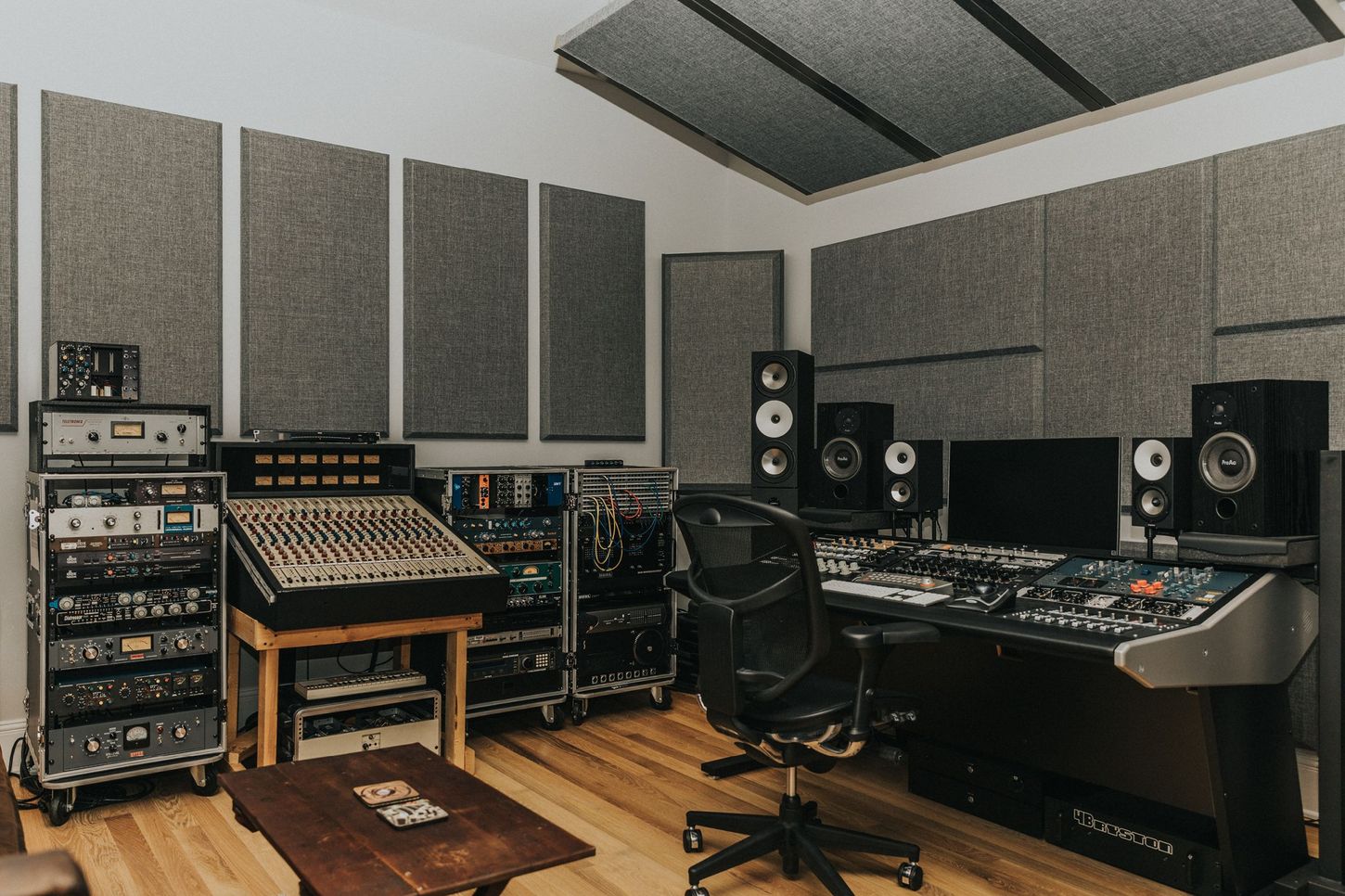Home>Production & Technology>Acoustic>How To Perform Acoustic Treatment


Acoustic
How To Perform Acoustic Treatment
Published: March 12, 2024
Learn how to effectively perform acoustic treatment to improve sound quality in your space. Discover the best techniques and products for optimal acoustic performance.
(Many of the links in this article redirect to a specific reviewed product. Your purchase of these products through affiliate links helps to generate commission for AudioLover.com, at no extra cost. Learn more)
Table of Contents
Introduction
Welcome to the world of acoustic treatment! Whether you're a musician, a podcaster, a sound engineer, or simply an audiophile, understanding the importance of acoustic treatment is crucial for achieving optimal sound quality in any space. Acoustic treatment involves the strategic placement of materials to control sound reflections, reverberations, and overall acoustics within a room. By addressing these factors, you can significantly enhance the clarity, balance, and accuracy of the sound, ultimately creating a more immersive and enjoyable listening experience.
In the following sections, we will delve into the fundamentals of acoustic treatment, exploring the selection and placement of acoustic panels, the distinction between diffusion and absorption, and even DIY options for those who are inclined to get hands-on. Whether you're setting up a home recording studio, refining the acoustics of a listening room, or seeking to optimize the sound in a commercial space, this guide will equip you with the knowledge and insights needed to embark on your acoustic treatment journey.
Acoustic treatment is not just about addressing the sound within a space; it's about sculpting the sonic environment to bring out the best in the audio being produced or enjoyed. It's about taming unwanted echoes, reducing excessive reverberations, and minimizing the impact of standing waves. By doing so, you can unlock the true potential of your speakers, microphones, and musical instruments, allowing them to perform at their best without the interference of acoustic anomalies.
So, whether you're a seasoned professional or a newcomer to the world of acoustics, join us as we explore the art and science of acoustic treatment. Together, we'll uncover the secrets to transforming any room into an acoustically optimized haven for pristine sound reproduction. Let's embark on this sonic adventure and unlock the full potential of your listening environment!
Understanding Acoustic Treatment
Acoustic treatment is the art of controlling sound within a space to achieve the desired sonic characteristics. It involves the strategic placement of acoustic panels, bass traps, diffusers, and other materials to manage sound reflections, reverberations, and overall room acoustics. By addressing these factors, the goal is to create an environment where sound behaves predictably and accurately, without unwanted coloration or distortion.
One of the key principles of acoustic treatment is to minimize the impact of room modes, which are the resonant frequencies that occur between parallel surfaces in a room. These modes can cause uneven bass response and create peaks and nulls at certain frequencies, leading to an unbalanced sound. Through the use of bass traps and strategic positioning of acoustic panels, these room modes can be mitigated, resulting in a more even and controlled low-frequency response.
Another important aspect of acoustic treatment is managing early reflections. When sound is produced in a room, it first reaches the listener directly, but it also reflects off the walls, ceiling, and floor. These early reflections can cause comb filtering and smearing of the sound, leading to a less defined and clear listening experience. Acoustic panels strategically placed at reflection points can help absorb these early reflections, improving the clarity and focus of the sound.
Furthermore, acoustic treatment aims to address reverberation time, which is the duration it takes for sound to decay by 60 dB after the sound source stops. Excessive reverberation can muddy the sound and reduce intelligibility, especially in speech and vocal recordings. By strategically placing absorption panels and diffusers, the reverberation time can be controlled, leading to a more controlled and articulate sound.
Understanding the fundamentals of acoustic treatment is essential for anyone looking to optimize their listening environment. By addressing room modes, early reflections, and reverberation, it is possible to create a space where sound behaves predictably and accurately, allowing for a more immersive and enjoyable listening experience. In the following sections, we will explore the practical aspects of selecting the right materials, the placement of acoustic panels, and the distinction between diffusion and absorption, providing a comprehensive guide to achieving optimal acoustics in any space.
Selecting the Right Materials
When it comes to acoustic treatment, selecting the right materials is paramount to achieving the desired sonic results. The choice of materials plays a crucial role in controlling sound reflections, managing reverberations, and optimizing the overall acoustics of a space. Here are the key materials to consider when embarking on an acoustic treatment project:
Acoustic Panels:
Acoustic panels are designed to absorb sound energy, reducing the level of reflected sound within a room. These panels are typically made from dense, acoustically transparent materials such as fiberglass or mineral wool, encased in fabric to allow sound to pass through and be absorbed. When selecting acoustic panels, it's important to consider the thickness and density of the material, as well as the fabric covering, to ensure optimal absorption across a broad frequency range.
Bass Traps:
Low-frequency sound waves can accumulate in the corners of a room, leading to uneven bass response and potential boomy or muddy characteristics. Bass traps are specifically designed to address these low-frequency issues by absorbing or diffusing bass energy. When selecting bass traps, consider their placement in room corners and along wall-ceiling or wall-floor junctions to effectively manage low-frequency buildup.
Diffusers:
While absorption panels reduce the level of reflected sound, diffusers scatter sound waves in various directions, helping to maintain a sense of spaciousness and natural ambience within a room. Diffusers are particularly useful in controlling mid and high-frequency reflections without overly deadening the room. When choosing diffusers, consider their design and scattering properties to ensure they effectively disperse sound energy while preserving the room's liveliness.
Acoustic Fabrics:
The choice of fabric used to cover acoustic panels and diffusers can impact their acoustic performance. Acoustic fabrics should be acoustically transparent, allowing sound to pass through to the underlying absorption or diffusion materials. Additionally, the aesthetic appeal and fire-retardant properties of the fabric should be taken into consideration when selecting the appropriate covering for acoustic treatments.
Reflective Surfaces:
In some cases, strategic use of reflective surfaces can enhance the acoustics of a room by directing sound energy towards desired listening areas. Materials such as wood, glass, or certain types of wall treatments can be utilized to create controlled reflections and add a sense of warmth and liveliness to the sound environment.
By carefully selecting and integrating these materials into a room, it is possible to sculpt the sonic characteristics with precision, creating an environment where sound behaves predictably and accurately. The combination of acoustic panels, bass traps, diffusers, and carefully chosen fabrics and surfaces can significantly improve the overall acoustics of a space, leading to a more immersive and enjoyable listening experience.
Placement of Acoustic Panels
Strategic placement of acoustic panels is crucial in optimizing the acoustics of a room. By strategically positioning these panels, the impact of sound reflections, early reflections, and reverberations can be effectively managed, leading to a more balanced and controlled sound environment.
Reflection Points:
Identifying the reflection points within a room is the first step in determining where acoustic panels should be placed. These reflection points are where sound waves bounce off surfaces before reaching the listener. Common reflection points include the walls directly facing the speakers and the ceiling above the listening area. By placing acoustic panels at these reflection points, the early reflections can be absorbed, reducing the potential for comb filtering and smearing of the sound.
First Reflection Points for Stereo Imaging:
In a stereo listening environment, the first reflection points for each speaker are critical for maintaining accurate stereo imaging. Placing acoustic panels at the first reflection points ensures that the sound arriving at the listener's ears is predominantly from the speakers, rather than from reflections off the walls. This enhances the clarity and precision of the stereo image, allowing for a more immersive listening experience.
Rear Wall and Corners:
The rear wall and corners of a room are areas where sound energy can accumulate, leading to excessive reflections and potential bass buildup. Placing bass traps in these areas helps to absorb low-frequency energy and reduce the impact of room modes, resulting in a more even and controlled bass response. Additionally, diffusers can be strategically placed on the rear wall to scatter mid and high-frequency reflections, contributing to a more balanced and spacious sound environment.
Ceiling and Floor:
The ceiling and floor also play a significant role in the propagation of sound within a room. By incorporating acoustic panels on the ceiling and floor, early reflections and reverberations can be managed, contributing to a more controlled and articulate sound. In spaces with hard flooring, the use of area rugs or acoustic treatments on the floor can help reduce the potential for excessive reflections and reverberations.
Flexibility and Experimentation:
It's important to note that the placement of acoustic panels is not a one-size-fits-all approach. Room dimensions, speaker placement, and the specific sonic characteristics of the space all play a role in determining the optimal placement of acoustic treatments. Experimentation with different panel placements and configurations can help fine-tune the acoustics to suit the specific listening environment, allowing for a customized approach to achieving optimal sound quality.
By carefully considering the reflection points, stereo imaging, rear wall and corners, as well as the ceiling and floor, the placement of acoustic panels can significantly impact the overall acoustics of a room. Through thoughtful placement and experimentation, it is possible to create a sonic environment that enhances the listening experience, allowing for the full potential of the audio to be realized.
Diffusion vs. Absorption
In the realm of acoustic treatment, understanding the distinction between diffusion and absorption is essential for sculpting the sonic characteristics of a room. Both diffusion and absorption play distinct roles in managing sound reflections and reverberations, contributing to a balanced and controlled acoustic environment.
Absorption:
Absorption involves the conversion of sound energy into heat within the absorbing material. This process reduces the level of reflected sound within a room, effectively controlling reverberation and early reflections. Absorption panels, typically made from materials such as fiberglass or mineral wool, are strategically placed to capture and convert sound energy, resulting in a more controlled and articulate sound environment. These panels are particularly effective in managing mid and high-frequency reflections, contributing to improved clarity and focus in the listening space.
Diffusion:
Diffusion, on the other hand, scatters sound energy in various directions, breaking up direct reflections and creating a sense of spaciousness within a room. Diffusers are designed to preserve the natural ambience of a space while controlling the buildup of mid and high-frequency reflections. By dispersing sound energy evenly throughout the room, diffusers help maintain a sense of liveliness and openness without overly deadening the acoustics. This is particularly beneficial in environments where a balance between absorption and diffusion is desired, such as in recording studios, home theaters, and listening rooms.
Balancing Absorption and Diffusion:
The key to achieving optimal acoustics lies in striking a balance between absorption and diffusion. In many cases, a combination of both techniques is employed to address different aspects of the sound environment. By strategically placing absorption panels at reflection points and areas prone to excessive reverberation, early reflections can be managed, leading to improved clarity and precision in the sound. Meanwhile, diffusers can be utilized to scatter sound energy in a controlled manner, preserving the natural ambience of the room while minimizing the impact of direct reflections.
Tailoring Acoustic Characteristics:
The choice between diffusion and absorption, as well as the specific placement of diffusers and absorption panels, can be tailored to suit the unique sonic characteristics of a room. Factors such as room size, speaker placement, and the intended use of the space all influence the decision to emphasize diffusion or absorption in specific areas. By carefully considering these factors, it is possible to create a customized acoustic environment that enhances the listening experience and optimizes the sonic potential of the space.
In summary, understanding the roles of diffusion and absorption in acoustic treatment is fundamental to achieving balanced and controlled acoustics. By strategically incorporating both techniques and tailoring their application to suit the specific characteristics of a room, it is possible to create a sonic environment that enhances the listening experience and allows for the full potential of the audio to be realized.
DIY Acoustic Treatment
Embarking on a do-it-yourself (DIY) acoustic treatment project can be a rewarding and cost-effective way to optimize the sound quality of a room. Whether you're setting up a home recording studio, refining the acoustics of a listening room, or seeking to enhance the sound in a home theater, DIY acoustic treatment offers a customizable approach to achieving optimal acoustics. Here are some practical and creative DIY acoustic treatment ideas to elevate your listening environment:
1. DIY Acoustic Panels:
Crafting your own acoustic panels allows for customization in both aesthetics and acoustical performance. By constructing wooden frames and filling them with dense insulation material such as rockwool or fiberglass, you can create effective absorption panels. Cover the panels with acoustically transparent fabric to complete the DIY acoustic panels. This approach provides flexibility in choosing fabric colors and patterns to complement the room's decor while improving the sound quality.
2. Homemade Bass Traps:
Addressing low-frequency issues can be achieved through DIY bass traps. By constructing triangular bass traps using insulation material and fabric, you can effectively manage low-frequency buildup in room corners. These DIY bass traps can be strategically placed to absorb excessive bass energy, contributing to a more balanced and controlled low-frequency response.
3. Upcycled Diffusers:
Repurposing materials to create diffusers is a creative and sustainable DIY approach. By arranging wooden blocks or other geometric shapes on a panel, you can design and build your own diffusers. These upcycled diffusers scatter sound energy, contributing to a sense of spaciousness and natural ambience within the room while adding a unique visual element to the acoustic treatment.
4. Area Rug Acoustic Enhancement:
In spaces with hard flooring, incorporating area rugs can contribute to acoustic improvement. DIY rug underlay made from dense, acoustically absorbent material can help reduce excessive reflections and reverberations, particularly in high-traffic areas. This simple yet effective DIY approach enhances the overall acoustics of the room while adding a touch of comfort and style.
5. Customized Reflection Point Treatment:
Identifying and addressing reflection points with DIY solutions can significantly improve the listening environment. By strategically placing DIY acoustic panels at reflection points, such as the walls directly facing the speakers, you can effectively manage early reflections, contributing to improved stereo imaging and clarity.
By embracing the DIY approach to acoustic treatment, you have the opportunity to tailor the solutions to your specific needs and preferences. Whether it's customizing the aesthetics of acoustic panels or repurposing materials for creative diffusers, DIY acoustic treatment empowers you to optimize the sound quality of your space while adding a personal touch to the acoustic environment. With a blend of creativity, craftsmanship, and acoustical knowledge, DIY acoustic treatment can elevate the listening experience and unlock the full sonic potential of any room.
Conclusion
In conclusion, the art and science of acoustic treatment offer a transformative journey towards achieving optimal sound quality in any space. By understanding the principles of managing sound reflections, controlling reverberations, and addressing room modes, individuals can unlock the full potential of their listening environments. The strategic selection and placement of acoustic materials, including panels, bass traps, diffusers, and fabrics, play a pivotal role in sculpting the sonic characteristics of a room.
The distinction between diffusion and absorption, as well as the balance between the two, provides a nuanced approach to managing sound energy and creating a balanced and controlled acoustic environment. Whether it's enhancing stereo imaging, managing low-frequency buildup, or preserving the natural ambience of a space, the interplay between diffusion and absorption allows for a customized approach to acoustical optimization.
Furthermore, the realm of DIY acoustic treatment offers a creative and cost-effective avenue for individuals to tailor their acoustic solutions to suit their specific needs and preferences. From crafting custom acoustic panels and bass traps to repurposing materials for unique diffusers, the DIY approach empowers individuals to take ownership of their acoustic environments while adding a personal touch to the overall aesthetic.
Ultimately, the goal of acoustic treatment is to create a space where sound behaves predictably and accurately, allowing for an immersive and enjoyable listening experience. Whether it's in a home recording studio, a dedicated listening room, or a commercial space, the principles of acoustic treatment can be applied to elevate the sonic potential of any environment.
As we conclude this exploration of acoustic treatment, it's evident that the fusion of artistry, science, and creativity is at the heart of sculpting the sonic landscape. By embracing the principles outlined in this guide and infusing them with individual creativity, anyone can embark on a sonic adventure, transforming their listening environment into a haven for pristine sound reproduction. With a deeper understanding of acoustic treatment, individuals are empowered to embark on a journey that transcends the realm of sound, ultimately enhancing the way we experience and interact with the auditory world around us.











